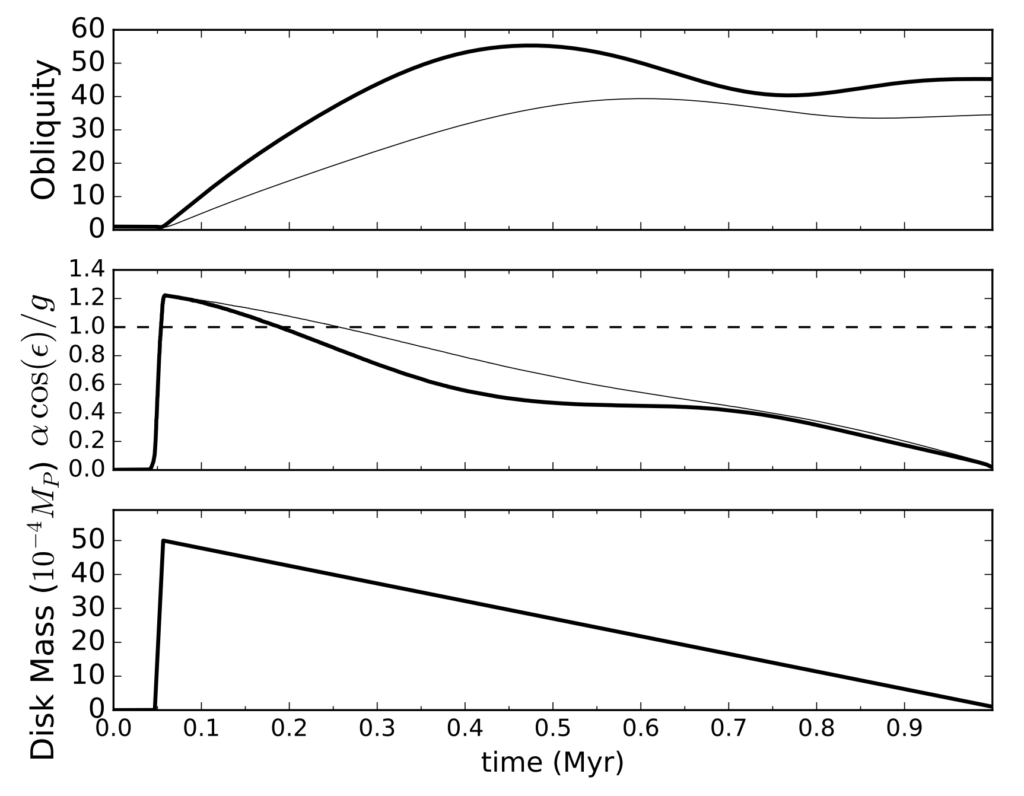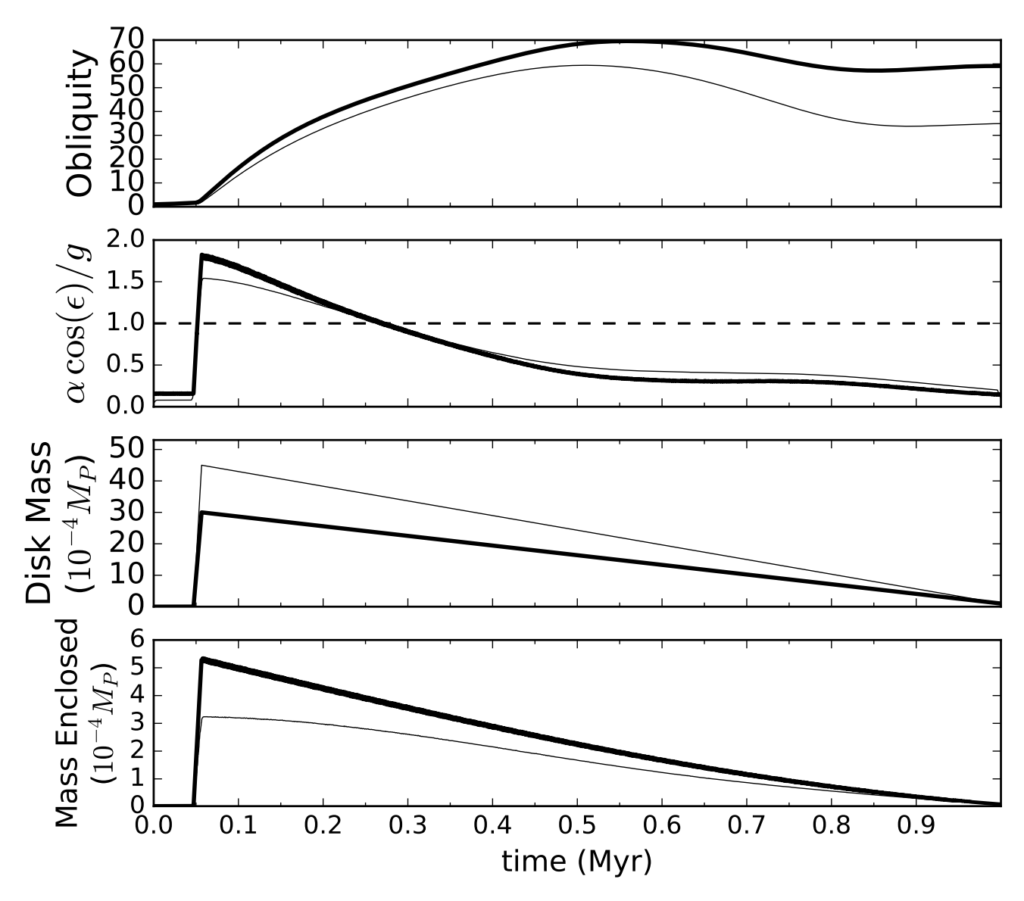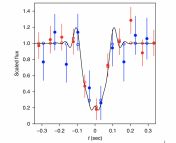Title: Tilting Ice Giants with a Spin-Orbit Resonance
Authors: Zeeve Rogoszinski and Douglas Hamilton
First Author’s Institution: University of Maryland, College Park
Status: Published in The Astrophysical Journal [closed access]
Songs about the solar system were a significant part of my childhood. These songs taught one fact about each of the 9 planets (these were the pre-Pluto’s-demotion days) and yes, I find myself singing them in the shower every now and then. The fact about Uranus is always the same: “Uranus spins on its side.” Not only is this bizarre and memorable to a child, it happens to be true. Uranus has an obliquity (tilt) of 98º, making its axis of rotation closer to the ecliptic plane than any other planet. And yet, nobody knows how it got that way.
Problems with the Current Theory
The conventional wisdom for many years has been that one or more giant impacts must have turned Uranus onto its side when it was very young and giant impacts were common. The authors of today’s paper outline four potential problems with this theory.
1If Uranus were impacted many times but Neptune were not, one would expect their rotation rates to differ significantly. The reason is that some of the impacts might have sped up or slowed down Uranus’ rotation. Instead a day on Uranus and Neptune only differs by 6% (17.2 hours vs. 16.2 hours, respectively).
2Giant impacts would disrupt the satellites orbiting Uranus. If this were true, the authors argue, the mass of all of Uranus’ moons would be lower than expected. Instead, the find Uranus has the “appropriate” amount of moons.
3It’s extremely hard to design one impactor large enough to tilt Uranus. That doesn’t mean multiple impacts are out of the question, but it is a challenging scenario to model.
4Giant impacts would have heated Uranus so much that a lot of the interior ice would have been sublimated to gas and ejected into space. If this occurred, Uranus’ satellites would be mostly ice, but they are actually mostly rock and only a little ice.
The authors propose a different way to tilt Uranus: spin-orbit resonance caused by a massive circumplanetary disk. To determine if this is possible, they simulated a young Uranus and Neptune evolving, each with a large orbiting disk of dust and gas.
What is Spin-Orbit Resonance?
Resonance is when two periods are integer multiples of each other. Think of pushing a kid on a swing. If you push at the right period, the swing will go high but if you push at other times, it won’t be as much fun. An example of orbital resonance is Neptune and Pluto. Pluto orbits the sun twice for every three times Neptune orbits, so Pluto’s orbit is reasonably stable. Spin-orbit resonance is a type of secular resonance, meaning the precession of Uranus’ spin axis resonates with Uranus’ orbit. Orbital precession means that the orbit changes orientation over time, causing the pole to point in a different direction, as shown by Figure 1.

Normally, precession happens way too slowly to resonate with orbits. For instance, Earth takes 26,000 years to precess once but its orbital period is only one year. In this paper, the authors impart Uranus with spin-orbit resonance by increasing its precession, which is a result of having a circumplanetary disk.
Growing a Tilted Ice Giant
As the ice giants formed, they each had a circumplanetary disk. Disks are relatively short lived and only hang around for about 1 million years before the material either falls into the planet or forms a moon. That means Uranus only has one million years to turn on its side before the disk dissipates and the tilt is permanent.
In order to determine if different types of disks are capable of tilting Uranus or Neptune, the authors built computer models that capture the physical interactions of the disk and the planet. Three of the most important models are summarized here.


Model 1 is the simplest. It has a disk with constant mass for 1 million years before dissipating instantly. The result is shown in Figure 2, where the obliquity (top panel) can be seen changing from 0º up to about 65º and then back to 0º. The authors find that a constant disk could cause Uranus to tilt, but it could just as easily undo the tilt, making it too unpredictable.
Model 2 contains a more realistic disk that slowly dissipates over one million years, as shown in Figure 3 (bottom panel). The obliquity (top panel) reaches a maximum of about 55º and then settles to about 45º. A dissipating disk does a better job of keeping Uranus tilted, but 45º is not even half of the tilt seen today.
Model 3 is the same as model 2, but Uranus grows in mass as material from the disk falls onto it, shown in Figure 4. Here the obliquity (top panel) reaches a maximum of about 70º and settles to 60º once the disk is gone. This model gets closest to the current value of 98º, but is still not tilty enough.
One Last Tilt

The authors find that model 3 is the most realistic because it accurately captures orbital physics while plausibly tilting Uranus up to a maximum of 70º. They conclude that this supports the hypothesis that spin-orbit resonance could be responsible for Uranus’ high obliquity. They add that it would still take a massive impact, most likely, to push Uranus from 70º up to 98º, but a single impact is significantly more likely than a series of giant impacts.
The authors created many more spin-orbit models than shown here in their attempt to explain the evolution of Uranus and Neptune. As encouraging as it is that some of these models reproduce observed effects, understanding a process that occurred nearly five billion years ago, with only extremely limited observational data, will always be challenging.
Cover image credit: NASA.




